Discover 11 hidden attractions, cool sights, and unusual things to do in Medina (Saudi Arabia). Don't miss out on these must-see attractions: Al-Masjid an-Nabawi, Green Dome, and Al-Baqi'. Also, be sure to include Quba Mosque in your itinerary.
Below, you can find the list of the most amazing places you should visit in Medina (Al Madinah).
Table of Contents
Al-Masjid an-Nabawi
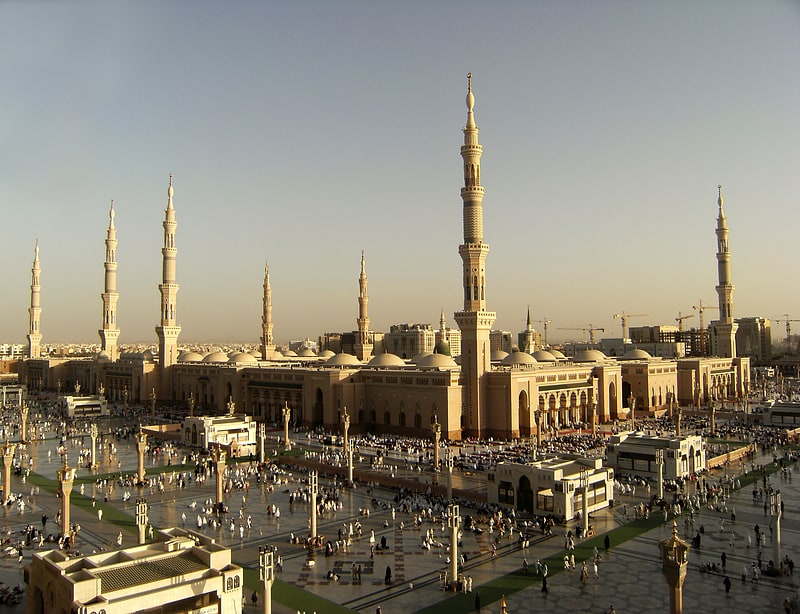
Also known as: المسجد النبوي
Mosque built by the prophet Muhammad. Al-Masjid an-Nabawi, known in English as The Prophet's Mosque, is a mosque built by the Islamic prophet Muhammad in the city of Medina in the Al Madinah Province of Saudi Arabia. It was the second mosque built by Muhammad in Medina, after Masjid Quba', and is the second largest mosque and second holiest site in Islam, both titles ranking after the Masjid al-Haram in Mecca. It is generally open regardless of date or time, and has only been closed to visitors once in modern times, as Ramadan approached during the 2020 COVID-19 pandemic.
The land of Al-Masjid an-Nabawi belonged to two young orphans, Sahl and Suhayl, and when they came to know that Muhammad wished to acquire their land for the purposes of erecting a mosque, they went to Muhammad and offered the land to him as a gift; Muhammad insisted on paying a price for the land because they were orphaned children. The price agreed upon was paid by Abu Ayyub al-Ansari, who thus became the endower or donor (Arabic: واقِف, romanized: waqif) of Al-Masjid an-Nabawi on behalf of, or in favor of, Muhammad. al-Ansari also accommodated Muhammad upon his arrival at Medina in 622.
Muhammad shared in the construction of the mosque. Originally an open-air building, the mosque served as a community center, a court of law, and a religious school. There was a raised platform or pulpit (minbar) for the people who taught the Quran and for Muhammad to give the Friday sermon (khutbah). Subsequent Islamic rulers greatly expanded and decorated the mosque, naming its walls, doors and minarets after themselves and their forefathers.
After an expansion during the reign of the Umayyad caliph Al-Walid I, it now incorporates the final resting place of Muhammad and the first two Rashidun caliphs Abu Bakr and Umar. One of the most notable features of the site is the Green Dome in the south-east corner of the mosque, originally Aisha's house, where the tomb of Muhammad is located. Many pilgrims who perform the Hajj also go to Medina to visit (Ziyarah) the Green Dome. In 1909, under the reign of Ottoman Sultan Abdul Hamid II, it became the first place in the Arabian Peninsula to be provided with electrical lights. The mosque is under the control of the Custodian of the Two Holy Mosques. The mosque is located at the heart of Medina and is a major pilgrimage site.[1]
Green Dome

Also known as: القبة الخضراء
Masjid in Medina, Saudi Arabia. The Green Dome is a green-coloured dome built above the tombs of the Islamic prophet Muhammad, the early Rashidun Caliphs, Abu Bakr and Umar, which used to be Aisha's chamber. The dome is located in the southeast corner of Al-Masjid al-Nabawi in Medina. Millions visit it every year, since it is a tradition to visit the mosque after the pilgrimage to Mecca.
The structure dates back to 1279 CE, when an unpainted wooden cupola was built over the tomb. It was later rebuilt and painted using different colours twice in the late 15th century and once in 1817. The dome was first painted green in 1837, and hence became known as the "Green Dome".[2]
Al-Baqi'
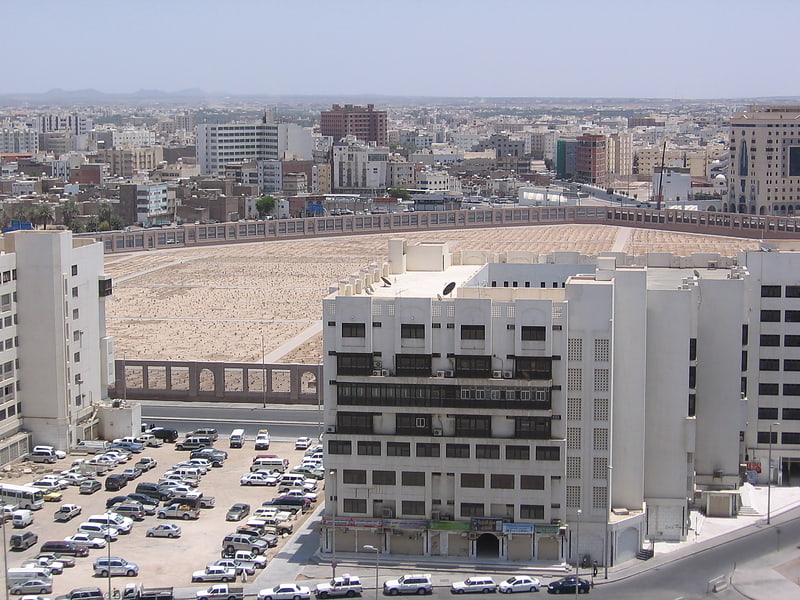
Also known as: البقيع
Cemetery in Medina, Saudi Arabia. Al-Baqi Cemetery is an Islamic cemetery in Medina, Hejaz, located to the southeast of the Prophet's Mosque. It was the first Medinian Islamic cemetery, containing graves of many of the Islamic prophet Muhammad's family and companions.
The grounds hold much significance for Muslims, being the resting place of many of Muhammad's relatives and companions, thus marking it as one of the two holiest cemeteries in Islamic tradition, along with the al-Mualla cemetery in Mecca. Many narrations relate Muhammad issuing a prayer every time he passed it.[3]
Address: K. Abdulaziz Road, Medina
Quba Mosque

Also known as: مسجد قباء
Mosque in Medina, Saudi Arabia. The Quba Mosque is a mosque located on the outskirts of Medina, Saudi Arabia. Initially, the mosque was built 6 kilometres off Medina in the village of Quba, before Medina expanded to include this village. Depending on whether the Mosque of the Companions in the Eritrean city of Massawa is older or not, it may be the first mosque in the world that dates to the lifetime of the Islamic prophet Muhammad in the 7th century CE. According to records, its first stones were positioned by Muhammad as soon as he arrived on his emigration from the city of Mecca to Medina, and the mosque was completed by his companions. Muhammad spent 14 days in this mosque praying qaṣr while waiting for Ali to arrive in Medina, after the latter stayed behind in Mecca to safeguard Muhammad’s life and safe escape by sleeping in Muhammad’s bed in his place, an event referred to in the Quran, sura al Baqara verse 207. Also going along with traditional saying, this mosque is said to be where the first Friday prayer was held, led by Muhammad.
According to Islamic tradition, performing Wuḍūʾ ('Ablution') in one's home then offering two Rakaʿāt of Nafl (Optional) prayers in the Quba Mosque is equal to performing one ʿUmrah. Muhammad used to go there, riding or on foot, every Saturday and offer a two rakaʿāt-prayer. He advised others to do the same, saying, "Whoever makes ablutions at home and then goes and prays in the Mosque of Quba, he will have a reward like that of an 'Umrah." This ḥadīth was reported by Ahmad ibn Hanbal, Al-Nasa'i, Ibn Majah and Hakim al-Nishaburi. In keeping with traditional belief, this mosque is said to be the site of Muhammad's first Friday prayer.[4]
Address: 8074 طارق بن عبدالرحمن البجلي, Al Khatim, 42318 المدينة
Masjid al-Qiblatayn
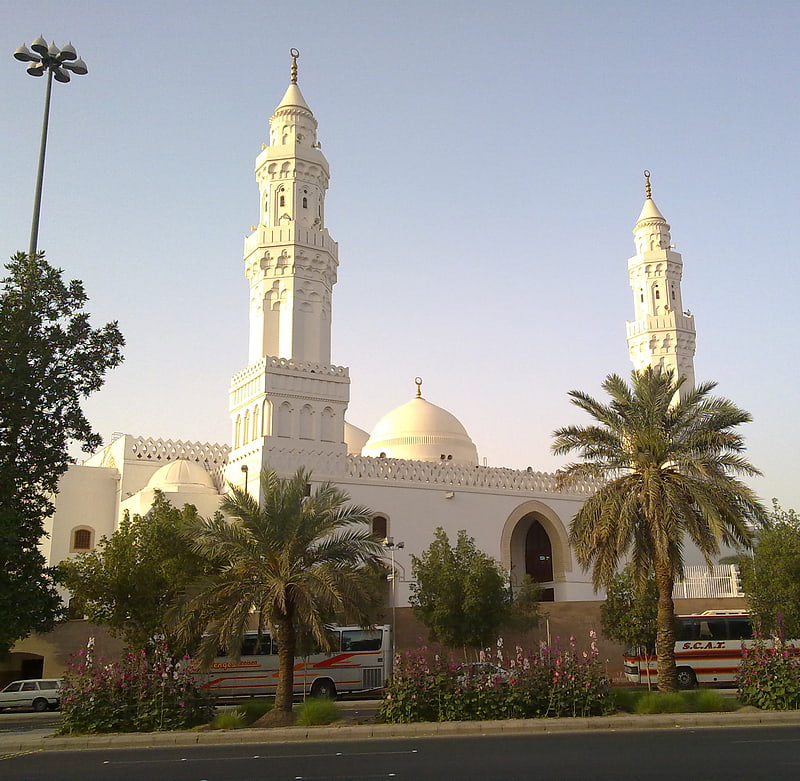
Also known as: مسجد القبلتين
Mosque in Medina, Saudi Arabia. The Masjid al-Qiblatayn, also spelt Masjid al-Qiblatain, is a mosque in Medina believed by Muslims to be the place where the final Islamic prophet, Muhammad, received the command to change the Qibla from Jerusalem to Mecca. The mosque was built by Sawad ibn Ghanam ibn Ka'ab during the year 2 AH and is one of the few mosques in the world to have contained two mihrabs in different directions.
In 1987, during the reign of King Fahd, the mosque was completely torn down and rebuilt. In the course of the reconstruction, the old prayer niche facing Jerusalem was removed, and the one facing Mecca was left. The Qiblatayn Mosque is among the earliest mosques that date to the time of Muhammad, along with the Quba'a Mosque and Masjid an-Nabawi, considering that the Great Mosques of Mecca and Jerusalem are associated with earlier Prophets in Islamic thought.[5]
Hejaz Railway Museum
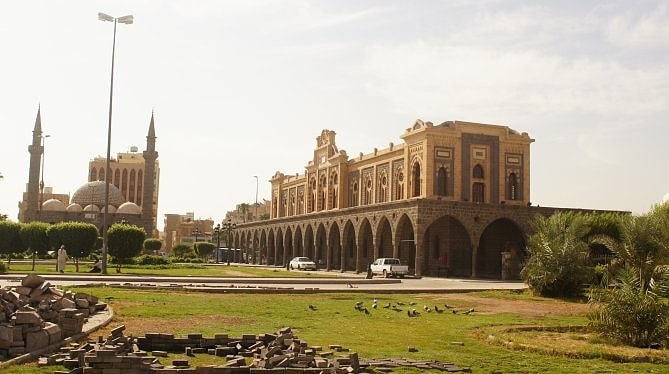
Also known as: متحف سكة الحجاز
Museum in Medina, Saudi Arabia. The Hejaz Railway Museum in Medina is a railway museum that was opened in 2006. It is on the grounds of the restored historic Ottoman railway station at Medina, locally called استسيون "Istasyōn", including a stretch of the historic track and a train shed with originally four tracks. There are several engines and pieces of rolling stock on display, some of which were transported to the museum from other places along the historic Hejaz railway line. At least one engine has been restored enough to be driveable on the museum tracks. It is, along with the old train station at Mada'in Saleh, one of two museums in Saudi Arabia dedicated to the Hejaz railway.[6]
Abu Bakr Mosque
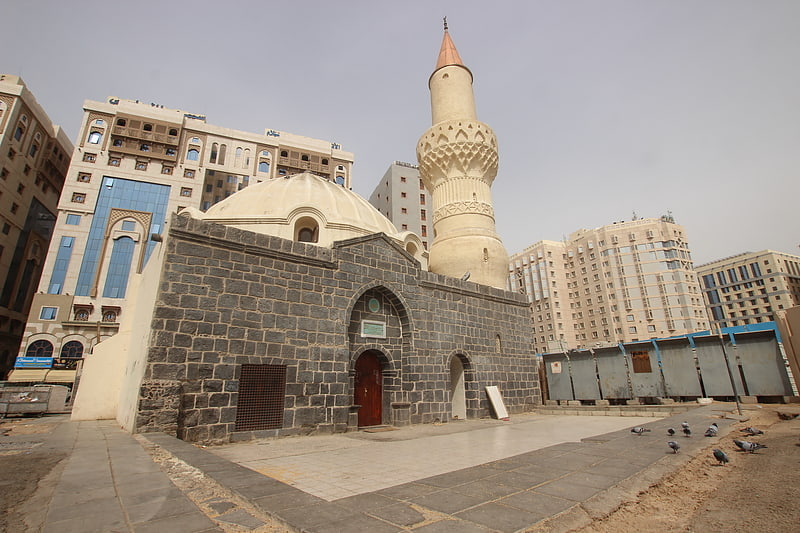
Mosque in Muadamiyat al-Qalamoun, Syria. The Abu Bakr Mosque is one of the oldest mosques in Medina, Saudi Arabia. It is located towards the south-west side of Al-Masjid an-Nabawi.
It is being said that it was a site where Muhammad used to offer Eid prayers and the same tradition was continued by Abu Bakr after Muhammad's death.[7]
Mosque of Al-Ghamama
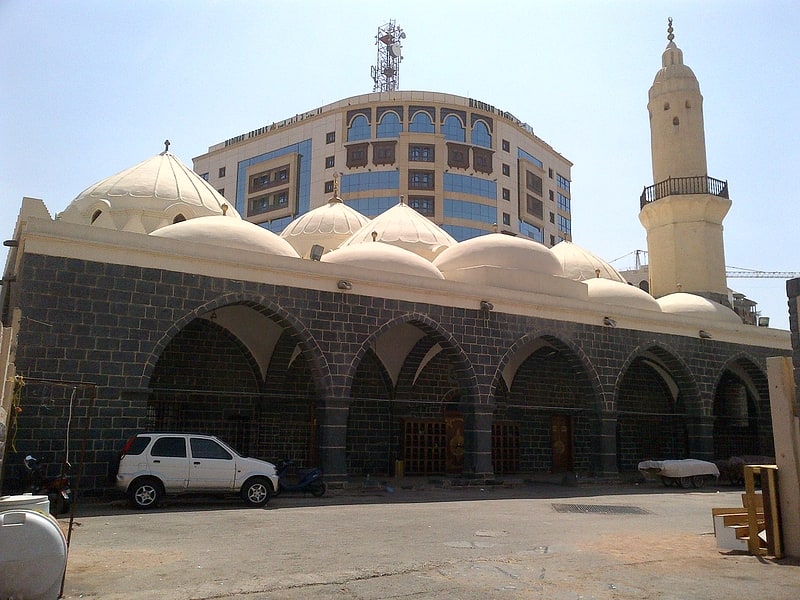
Also known as: مسجد الغمامة
Mosque in Medina, Saudi Arabia. Mosque of Al-Ghamamah is one of the oldest mosques in Medina, Saudi Arabia, located in the place believed to be where the Islamic prophet Muhammad performed an Eid prayer in the year 631. It is also narrated that Prophet Muhammad offered Salat ul-Istasqa when the city of Madina faced a shortage of rain. For a while, this mosque was closed for daily prayers because of its proximity to the Al-Masjid an-Nabawi. However quite recently it has been reopened for the worshipers for praying. Five times prayers are held in this mosque now with an internal sound system to avoid the clash of sounds from the Prophet's Mosque. The mosque is one of the historical relics of Medina.[8]
Al-Madinah Museum
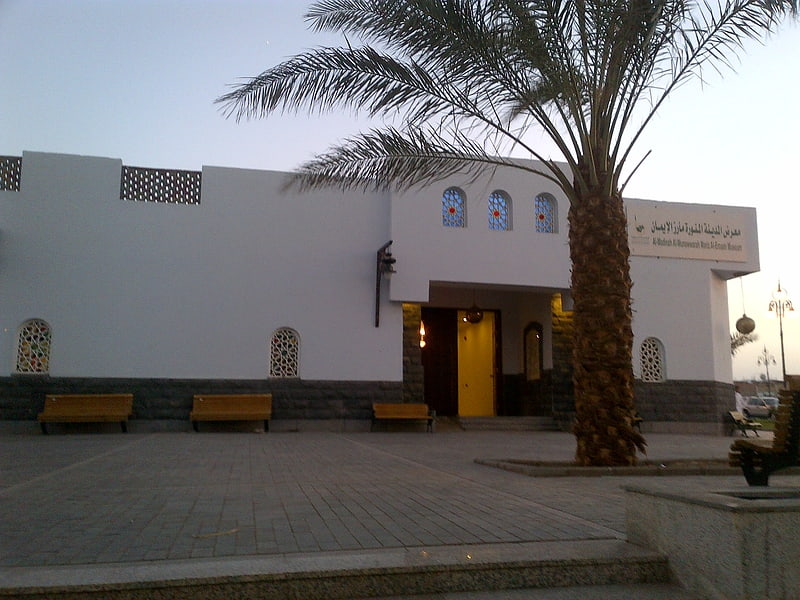
Al-Madinah Museum is a museum in Al-Madinah, Saudi Arabia, that exhibits Al-Madina heritage and history featuring different archaeological collections, visual galleries and rare images that related to Al-Medina. The museum exhibits around 2,000 rare artifacts that capture the heritage and culture of Al-Madinah and document the landscape, the people and how it has been shaped over the years. One of the most interesting parts of the tour is the evolution of Masjid Nabawi from a house, courtyard, and home to the massive complex that it is now.[9]
Address: Omar Ibn Alkhtab Rd, Medina
Anbariya Mosque

Also known as: مسجد العنبرية
Mosque in Medina, Saudi Arabia. The Anbariya Mosque, also known as the Hamidiye Mosque, is a mosque built by the Ottoman Turks in Medina, which is nowadays part of Saudi Arabia. It is named after the Anbariya Gate, next to which the mosque was located.
Built in 1908 by the Ottoman Sultan Abdülhamid II, The Anbariya Mosque was a part of the Hejaz Railway project next to al-Muazzim Railway Station, which houses the Hejaz Railway Museum.[10]
Address: Omar Ibn Alkhtab Rd, 42315 Medina
As-Sajadah Mosque
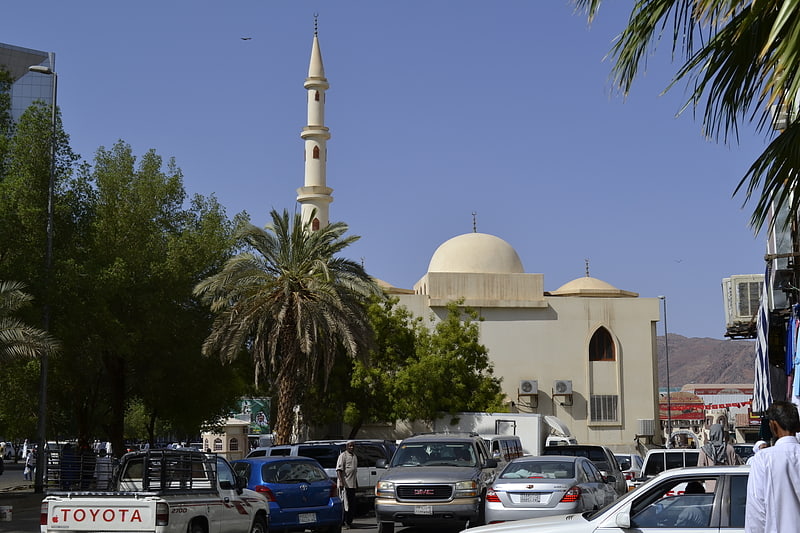
As-Sajadah Mosque, also known as Asy-Syukr Mosque or Abi Dzar Mosque, is a mosque located 900 meters north of Al-Masjid an-Nabawi in Medina, Saudi Arabia. The mosque is called "As-Sajadah" meaning "the prostration" because of an account of the Islamic prophet Muhammad prostrating here after hearing a good news from Gabriel regarding salawat. Today, it is better known as Abi Dzar Mosque because it is on Abi Dzar street. It has been renovated and expanded in 2000.[11]